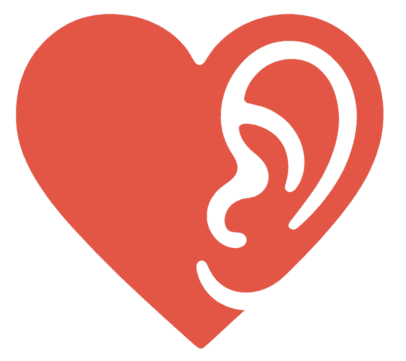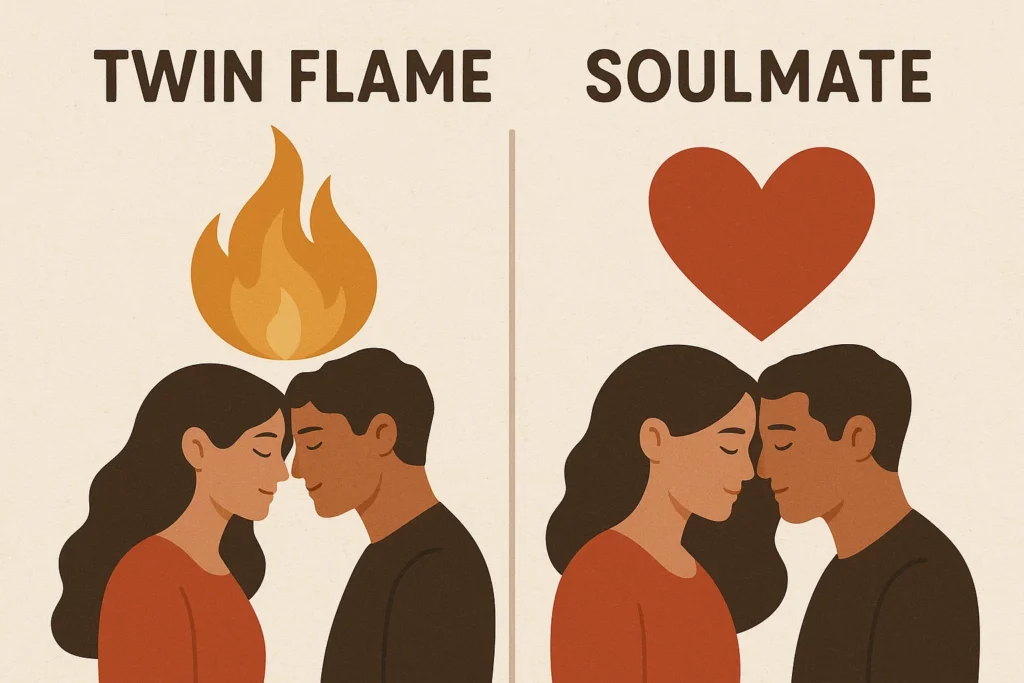We’re all looking for that connection, aren’t we? The one that feels different. The one that stops you in your tracks and makes you think, “Okay, this is it.”
In this universal search for love, we’ve created labels for these huge, life-altering bonds. The two that get tangled up the most are “soulmate” and “twin flame.”
I get it. I’ve been right there, using the terms interchangeably. For years, I figured they were the same thing. Both sounded magical. Both sounded destined. Both sounded like exactly what I was hoping to find.
Here’s the truth: They are not the same.
Not even close.
Figuring out the whole twin flame vs soulmate puzzle isn’t just about learning new spiritual lingo. It’s about understanding the purpose of your most significant relationships. One is here to give you a home. The other is here to burn your old house down (in the most loving, spiritual way possible, I promise) so you can build a new one.
My own life is the perfect example. For years, I was with a wonderful man I’ll call Mark. Our relationship was… easy. It was comfortable, supportive, and everything I’d ever been told love should be. A true soulmate. We parted as friends, and I thought, “That’s the kind of love I’m good at.”
And then Alex came along.
This wasn’t “easy.” This was a tidal wave. This connection was magnetic, chaotic, and it absolutely terrified me. He was a living, breathing mirror, forcing me to see every single flaw, every deep-seated fear, and every old wound I’d been covering up for years.
That’s when I truly understood the difference. This article is my story of sorting through that beautiful, painful discovery. We’re going to pull these two ideas apart and help you see the connections shaping your own life.
More in Niche, Social, and Spiritual Category
Key Takeaways
Before we dive in, here’s the cheat sheet. This is the core of the twin flame vs soulmate difference:
- Soulmates are your “soul family.” They feel like home. Their purpose is to support you, love you, and grow with you. You can have many soulmates.
- A Twin Flame is your “mirror soul.” This is one soul, split into two bodies. Their purpose is to ignite your growth, usually through intense challenges. It’s magnetic and often turbulent. You only have one.
- The Goal is Different: Soulmate relationships are often about building a harmonious life together. Twin flame connections are about your personal, rapid-fire spiritual growth, which may or may not lead to a partnership.
- Warning Label: An intense, painful connection is not automatically a twin flame. It’s critical to know the difference between a challenging spiritual bond and a relationship that’s simply toxic.
So, What Does “Soulmate” Actually Mean?
Let’s start with the familiar one. The one we all know and love. The “soulmate” concept is baked into our culture. It’s in every rom-com, every love song. It’s that “you complete me” idea.
But it’s a bit deeper than that.
A soulmate is, quite literally, a “mate” from your soul group. Think of it this way: You have a “soul family.” A whole crew of souls you’ve been traveling with for lifetimes. You’ve made these little agreements with each other. “Hey, I’ll meet you in 2005 and be your college roommate who gets you through that awful breakup.” “I’ll show up as your boss and teach you how to have confidence.”
This is why the connection feels so familiar. You’ve done this before.
When you meet a soulmate, there’s an immediate sense of ease. A deep, quiet click. That feeling of, “Oh, there you are. I’ve been looking for you.” You can be your complete, unfiltered, weird self with them, and they don’t just “get it,” they’re the same kind of weird. The relationship is a safe harbor. It’s nurturing. Its job is partnership, support, and growing together.
Have I Met a Soulmate Before?
Oh, you have almost certainly met several. You just might not have put that label on them.
My relationship with Mark was the definition of a soulmate bond. From our very first date, there was no anxiety. No games. It was just… easy. We respected each other’s silences as much as we enjoyed the conversation. We built a life that was just plain nice. Full of laughter, mutual respect, and a deep, comfortable love.
It was a soft place to land in a very hard world.
Mark is still a dear soul to me. He championed my dreams. He offered stability when my life felt like a circus. Our relationship taught me what healthy, supportive, adult love is supposed to feel like. And when it ended, it ended with gratitude, not drama. We’d learned our lessons. We parted as friends.
That’s the beauty of so many soulmate connections. They’re mature. They’re loving. They’re built on a foundation of genuine, rock-solid care.
Is a Soulmate Always Romantic?
This is the single biggest misconception, and the answer is a hard “no.”
We’re so conditioned to look for the romantic one that we often miss the soulmates standing right next to us. They show up in all kinds of packages.
- Your best friend since third grade, the one who has seen you at your absolute worst and still thinks you’re amazing.
- Your sibling who is your fiercest protector and biggest fan, even if you used to fight like cats and dogs.
- That one-in-a-million mentor who saw your potential before you did and pushed you to be better.
- Even that rescue dog who seems to read your mind and knows exactly when you need a cuddle.
These are your platonic soulmates. They are the pillars holding you up. The connections are just as deep, just as “destined,” and just as life-changing as any romantic partner’s. They are your anchors. Their role is to love you, see you, and walk beside you.
Can You Have More Than One Soulmate?
Yes! A thousand times, yes.
This is a non-negotiable difference in the twin flame vs soulmate discussion. You don’t just have one soulmate. Your soul family is huge!
You will meet many soulmates in your life. Each one arrives right on time, exactly when you need them. One might show up to teach you joy. Another to teach you resilience. A romantic soulmate teaches you how to build a life with someone. A platonic soulmate teaches you unconditional loyalty.
These connections are gifts. They’re here to make this human experience richer, safer, and more full of love.
Then What in the World is a Twin Flame?
Alright, now for the one that’s a lot more… complicated. If soulmates are your cozy “soul family,” a twin flame is something else entirely. This is where we get into the deep end of the spiritual pool.
The core belief is that a twin flame is the other half of your own soul.
The idea is that one single soul, at a very high spiritual level, chose to split into two separate bodies. Why? To experience duality (light/dark, male/female, etc.) and to accelerate its learning far faster than it could as one.
One soul. Two bodies. Here on Earth at the same time. This is why people call it a “mirror soul.”
Meeting your twin flame isn’t that gentle “click” of a soulmate.
It’s a bomb going off.
It’s an instant, profound, and often shocking level of recognition. You’re not just meeting a new person. You are, in a very real sense, meeting yourself in another body. And let me tell you, this connection is not about comfort. It is about truth.
Why Does a Twin Flame Connection Feel So… Intense?
The intensity comes from its purpose. A twin flame’s only job is to be a mirror.
And that mirror is unflinching. It shows you everything. Not just the good stuff, your light and your gifts. It shows you all the parts of yourself you’ve hidden, denied, or are ashamed of. Your darkness. Your ugliest wounds. Every insecurity. Every fear. Every piece of unresolved trauma you’ve successfully hidden from yourself for years. It all comes roaring to the surface.
This is why the twin flame vs soulmate distinction is so critical. A soulmate holds your hand in the dark. A twin flame is the dark, forcing you to find your own light.
This connection is a spiritual boot camp. It’s an activator. It is designed to trigger you, to challenge you, and to rocket-launch you into the most rapid period of personal and spiritual growth you will ever have.
My Own “Twin Flame” Collision
This brings me back to Mark and Alex. If Mark was a calm harbor, Alex was a category 5 hurricane.
I met him at a work conference, and it wasn’t a “spark.” It was a full-on electrical shock. A magnetic pull that was so strong it was physical. I felt like I’d known him for a thousand years, but at the same time, every alarm bell in my body was screaming.
Within a few weeks, I was barely functioning.
Why? He was a walking, talking mirror of my deepest wounds. That fear of abandonment I thought I’d handled? He was fiercely independent and would emotionally (and sometimes physically) disappear for days, triggering it so badly I could barely breathe. That insecurity about my worth? He had a critical eye that could find that wound and poke it without even knowing he was doing it.
Here’s the key: He wasn’t trying to hurt me. He wasn’t a bad guy. He was just being himself. His very presence was the trigger. I was forced to deal with my own issues. I had to set boundaries. I had to learn to love myself. I had to heal, or I was going to fall apart.
That is the twin flame mission. It’s not really about them. It’s all about you.
Is It Always a Romantic Relationship?
The energy between twin flames is almost always felt as an intense, magnetic romantic and sexual attraction. That’s usually what brings you together. How could it not be? You’re being drawn to the energy of your own soul.
But, and this is a big but, the purpose of the connection is spiritual growth, not necessarily a “happily ever after” partnership.
Many twin flames do not end up together in a traditional relationship. The intensity is just too much. Often, the purpose is to meet, ignite each other’s awakening, and then separate—sometimes for a very long time—to do the individual healing work that’s been exposed.
Some twin flames do come back together. This is called “union.” But it can only happen after both halves have done a significant amount of healing and raised their own energetic vibration. This is the “final exam,” not the starting point. The relationship is the reward for the healing, not the goal of it.
How Can I Tell the Difference in Real Life?
This is the hardest part, right? When you’re in it, the feelings are so big and confusing, it’s hard to read the map.
Let’s try to map out the practical differences.
The “Feeling”: Comfort vs. Chaos
Your gut knows. You have to learn to listen to it. How does this person really make you feel?
A soulmate connection feels like coming home. It’s a deep sigh of relief. It’s warm, safe, nurturing, and stable. You feel understood and accepted, flaws and all. The love grows and deepens, like a strong oak tree.
A twin flame connection feels like a lightning strike. It’s electric, magnetic, and deeply unsettling. It’s a feeling of divine recognition, followed immediately by turbulence. You’re constantly on edge, but you also feel more alive than you’ve ever felt.
The Purpose: Support vs. Spiritual Bootcamp
Why is this person in your life? What is their role?
A soulmate is here to be your partner. They’re on your team. They are your cheerleader and your co-pilot. You build a life together. You support each other’s goals. The relationship is a safe base from which you can both go out and conquer the world.
A twin flame is here to be your catalyst. They’re your spiritual drill sergeant. They are here to force you to face yourself. The connection is designed to break down your ego, trigger your wounds, and push you into healing. The primary purpose is your individual ascension.
The Connection: Familiarity vs. Magnetism
The nature of the bond itself feels different.
With a soulmate, the connection is built on shared experiences, deep affection, and growing trust. It feels familiar, like a favorite old friend, even at the beginning.
With a twin flame, the connection is an undeniable, energetic tether. This is where it gets a little “woo-woo,” but anyone who’s felt it will tell you it’s real.
- You might feel their emotions from a distance.
- You might have telepathic-like communication, knowing what they’re going to say.
- You’ll experience intense synchronicities (like seeing 11:11, their name, or their birthday everywhere).
- There’s a powerful magnetic pull that doesn’t fade, even if you’re apart or with other people.
The Number: Many vs. One
This is the simplest distinction of all.
You have many soulmates. You will have many of these beautiful, supportive, loving connections in your life, both platonic and romantic.
You have only one twin flame. Because they are, by definition, the other half of your one soul.
Here’s a quick-glance checklist to help you see the twin flame vs soulmate comparison more clearly:
| Feature | Soulmate Connection | Twin Flame Connection |
|---|---|---|
| The Feeling | Comfortable, safe, nurturing. Like coming home. | Intense, turbulent, magnetic. Like a lightning strike. |
| The Purpose | Support, partnership, and shared growth. | Spiritual awakening, healing, and rapid evolution. |
| The Speed | A steady, growing love. Builds over time. | Instant, shocking recognition. An “explosion.” |
| The Number | Many. You have a whole “soul family.” | Only one. The “other half” of your soul. |
| The Focus | On “us” — building a life together. | On “you” — forcing your individual healing. |
| The Core | A meeting of two compatible souls. | The recognition of one soul in two bodies. |
Why is the Twin Flame Journey So Hard?
I’m not going to sugarcoat this. The twin flame journey is brutal.
The internet loves to romanticize it as the “ultimate love story.” It’s not. For most people, it’s the “ultimate spiritual crisis.”
It’s hard because it’s designed to be.
It’s meant to shatter every false construct you’ve built around yourself. Your ego, that part of you that wants to stay safe, be in control, and protect its wounds, absolutely detests your twin flame. Their very presence is a threat to your ego’s entire-world.
This intensity often leads to the most painful part of the journey.
The Infamous “Runner and Chaser” Stage
This is a hallmark of the twin flame dynamic. As the intensity ramps up and all those deep-seated fears and wounds surge to the surface, it becomes too much for one or both partners.
This creates the “runner and chaser” dynamic.
- The Runner: This is typically the partner who is more overwhelmed by the connection and less in touch with their own unhealed trauma. The intensity feels like a threat. Their fear (of commitment, of being seen, of their own pain) becomes so great that they physically or emotionally run from the relationship. They might ghost, break it off suddenly, or create conflict to push the other person away.
- The Chaser: This is typically the partner who is more spiritually “awake” to the connection. They can feel the depth of the bond and are devastated by the separation. Their initial instinct is to chase—to text, to call, to demand answers, to try and “fix” the relationship.
This stage is not a romantic game of cat-and-mouse. It is a painful energetic dynamic. The chaser is chasing because they are seeking validation from the outside (from the runner). The runner is running because they are terrified of what the connection is showing them on the inside.
This painful cycle only stops when the chaser stops chasing and turns their focus inward. When they realize the real work is not to get the runner back, but to heal their own wounds of abandonment and self-worth. When they do this, the energetic pull shifts, and the runner is often given the space to face their own demons.
Is This “Twin Flame” Label Just an Excuse for a Toxic Relationship?
This is the most important part of the entire article. Please read this twice.
We must talk about this. Because of the “intense” and “challenging” nature of the twin flame dynamic, it can be, and often is, used to justify and spiritualize relationships that are simply toxic or abusive.
Let me be crystal clear: A twin flame is not an abuser.
A challenging connection is not the same as a damaging one. A twin flame will trigger your wounds. A toxic partner will create new ones and exploit your old ones.
Please, read this next part carefully.
- A Twin Flame Challenge: The connection pushes you toward self-love and independence. The pain you feel is your own stuff coming up to be healed.
- A Toxic Relationship: The connection fosters co-dependency and fear. The pain you feel is a direct result of being belittled, controlled, manipulated, or disrespected.
- A Twin Flame Challenge: Even in separation, there is an undercurrent of unconditional love. You want what’s best for them, even if it’s not you.
- A Toxic Relationship: The “love” is conditional and possessive. There are power games, jealousy, and a desire to control.
- A Twin Flame Challenge: The connection inspires you to be a better person, to heal, to grow, and to align with your highest purpose.
- A Toxic Relationship: The connection drains you, isolates you, and makes you feel small. It takes you away from your purpose and your support system.
If you are in a relationship that involves emotional, verbal, mental, or physical abuse, it is not a twin flame connection. It is an abusive situation, and your safety is the number one priority. A true divine connection will never ask you to sacrifice your safety, your sanity, or your self-worth.
What if My Partner is Neither? (And is that Okay?)
So you’re reading this and thinking, “Great. My partner isn’t a cozy soulmate, but they’re not a chaotic twin flame either. I’m just in a… relationship.”
That’s not just okay. That is beautiful.
We get so caught up in these spiritual labels that we forget the most important thing. Not every significant relationship has to fit into a neat, cosmic box.
The Beauty of a “Life Partner”
Sometimes, a relationship is simply a “life partnership.”
This is a connection built on conscious choice. It’s two whole, healthy individuals who look at each other and choose to build a life together. It’s built on shared values, mutual respect, commitment, and, yes, good old-fashioned love.
There doesn’t have to be a past-life pact or a “one soul, two bodies” explosion. It can just be a wonderful person who you love, and who loves you, and you both agree to do the work, day in and day out, to make it last. That’s not less spiritual. In many ways, that’s the most spiritual thing you can do.
In fact, the longest-running study on human happiness, the Harvard Study of Adult Development, found that the number one predictor of a long, happy, and healthy life wasn’t fame, or wealth, or career. It was the quality of our close relationships.
A committed, loving life partner is one of the greatest blessings on this planet. Don’t ever let a spiritual label make you feel like your “normal,” happy love is any less magical. It’s the most real magic there is.
What About Karmic Relationships?
There’s one more type of connection often mistaken for a twin flame: the “karmic relationship.”
A karmic relationship, like a twin flame, is also a catalyst for growth, but it’s for a different reason. It’s here to teach you a specific, hard lesson, often to clear karma from a past life. These relationships are usually passionate, all-consuming, and incredibly difficult. They are the “can’t live with them, can’t live without them” connections.
The key difference? A karmic relationship is meant to end. The lesson is the relationship. Once the karmic debt is paid and the lesson is learned (e.g., how to set boundaries, how to leave an unhealthy situation), the energetic tie is severed.
People often cling to these fiery, toxic-feeling relationships, thinking they are their twin flame. But a karmic connection is a loop. You repeat the same fights, the same patterns, over and over. A twin flame connection is an evolution. It forces you to break the patterns.
So, Which One Should I Be Looking For?
I know, it’s a lot. Soulmates, twin flames, karmics, life partners. It’s easy to get obsessed with the labels, to feel like you’re missing out, or that your painful relationship is “destined.”
Let’s throw all that out.
Here’s the real secret: You shouldn’t be looking for any of them.
The entire point of this human experience is not to find a specific person to complete you. The point is to become yourself, completely. The point is to heal your own wounds, to love your own soul, to build your own beautiful life.
Your only job is to focus on your own growth. To become the most whole, healed, and authentic version of yourself.
When you do that, you become a magnet. The right people—the soulmates who can support you and the life partners who can build with you—will be drawn to your light.
And if your journey includes a twin flame? If that divine catalyst is meant to find you?
Trust me on this. You won’t have to go looking.
They will find you.
FAQ – Twin Flame vs Soulmate
What is the fundamental difference between a soulmate and a twin flame?
A soulmate is your supportive and harmonious ‘soul family’ that supports your growth and feels like home, whereas a twin flame is your ‘mirror soul’ meant to ignite intense personal growth through challenging and transformative experiences.
Can I have more than one soulmate, and how does that compare to having a twin flame?
Yes, you can have many soulmates in your life, both platonic and romantic, as they are part of your soul family. In contrast, you typically have only one twin flame, as they are considered the other half of your one soul.
Is a twin flame relationship always romantic?
While twin flame relationships often involve intense romantic and sexual attraction, their primary purpose is spiritual growth and personal evolution. Many twin flames do not end up in traditional romantic partnerships but focus on individual healing.
How can I tell if I am experiencing a soulmate connection or a twin flame one?
A soulmate connection generally feels like coming home, being safe, and supported, with steady and growing love. A twin flame connection feels electric, chaotic, and intense, often accompanied by synchronicities and a magnetic pull that is hard to explain.
What is the main goal of each type of relationship, and how do they differ?
The goal of a soulmate relationship is support, partnership, and mutual growth, creating a harmonious life together. The purpose of a twin flame is to catalyze spiritual awakening and personal transformation through challenges that push you toward your highest self.




